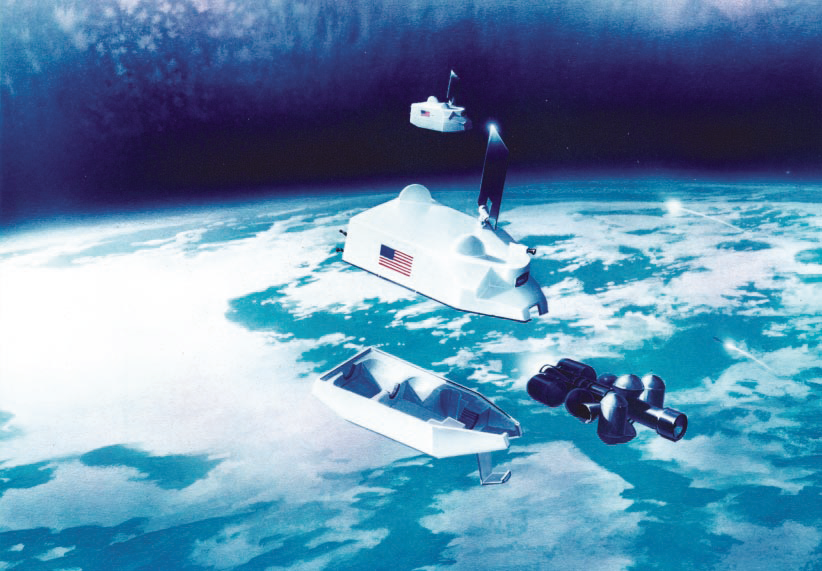The smallest individual spacecraft concept proposed for the Strategic Defense Initiative was the “Brilliant Pebbles” system. Instead of vast, multi-hundred-ton battle platforms like the lasers and neutral particle beams and railguns, Brilliant Pebbles were *relatively* small rocket vehicle designed to intercept enemy missiles and warheads while in space. The system was composed of a rocket-powered kill vehicle (usually fueled by dense, easily storable propellants such as nitric acid and hydrazine), and a “cocoon.” The latter was a shroud that protected the kill vehicle while it waited out the years floating in space.
The kill vehicle, in order to do its job, had to be *extremely* high performance. It was composed of a series of thrusters, lightweight composite propellant tanks, optics to spot and track the target, a computer to run it, communication systems, batteries… and not much else. The Brilliant Pebbles (so named because they were derived from the concept of “smart rocks,” which was a jovial way to describe a hit-to-kill system: instead of taking out the target with a warhead, you actually ram the target with your vehicle) vehicles were said to have the propulsive capability of boosting themselves out of Earth orbit and doing a fast flyby of Mars. This performance was needed in order to be able to launch from wherever they happened to be and race to intercept enemy missiles.
Data, such as mass and dimensions, is sadly lacking. Guesstimate that the cocoon is about the size of a Volkswagen. Where the bigger systems such as lasers would require heavy lift launchers, Brilliant Pebbles could be launched by much smaller rockets… and a whole lot of them. *Thousands* of Brilliant Pebbles would be needed in low Earth orbit to provide basic coverage. For every Brilliant Pebble that would be in place to take on a Soviet missile, many more would not be. It was the need to launch vast flocks of these that the SDI program began studying reusable, low-cost launchers, leading to the Delta Clipper program.

In the paper of Palmer & Lenard (1991) it is stated that Brilliant Pebbles have a mass of 50-100 kg.
“Strategic defenses based in space have been proposed which range from a few large platforms to many small ones. A likely near term candidate is the Brilliant Pebbles system which consists of several thousand 50-100 kg interceptors uniformly distributed in highly inclined low earth orbits.”
http://dx.doi.org/10.1109/20.100986
According to Morris (2004), “[i]n 1987 when Boeing was working on space based missiles under a program called Brilliant Pebbles […], the current technology at the time resulted in a payload of approximately 4.5 Kg and a final KV [Kill Vehicle] wet weight of approximately 19.5 Kg. […] [T]his KV resulted in a total interceptor mass [KV + Liquid Kick Stage + Solid Kick Motor] of approximately 1850 Kg.” Adding the Carrier Vehicle (not specified) mass doubles the weight of the object.
http://arc.aiaa.org/doi/abs/10.2514/6.2004-4140
The Boeing reference is interesting because it suggests a price of $76 billion for just the pebbles, when the entire system including the land-based missiles, Aegis/LEAP and all the detectors was supposed to be $55 billion.